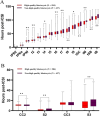Exploring key embryonic developmental morphokinetic parameters that affect clinical outcomes during the PGT cycle using time-lapse monitoring systems
- PMID: 39732641
- PMCID: PMC11681760
- DOI: 10.1186/s12884-024-07080-z
Exploring key embryonic developmental morphokinetic parameters that affect clinical outcomes during the PGT cycle using time-lapse monitoring systems
Abstract
Research question: Is it possible to predict blastocyst quality, embryo chromosomal ploidy, and clinical pregnancy outcome after single embryo transfer from embryo developmental morphokinetic parameters?
Design: The morphokinetic parameters of 1011 blastocysts from 227 patients undergoing preimplantation genetic testing were examined. Correlations between the morphokinetic parameters and the quality of blastocysts, chromosomal ploidy, and clinical pregnancy outcomes following the transfer of single blastocysts were retrospectively analyzed.
Results: The morphokinetic parameters of embryos in the high-quality blastocyst group were significantly shorter than those in the low-quality blastocyst group (p < 0.05). In contrast, the CC2 time was significantly prolonged (p < 0.05). On chromosomal analysis of biopsy blastocysts nourished by trophectoderm cells, in comparison to euploid embryos, aneuploid embryos exhibited significant extensions in tPNa, S3, tSC, tM, tSB, and tB (p < 0.05), with a simultaneous significant reduction in CC2 time (p < 0.05). After adjusting for age and body mass index through logistic regression analysis, late morphokinetic parameters, namely tM (OR 0.96; 95% CI 0.93-0.99), tSB (OR 0.94; 95% CI 0.90-0.97), and tB (OR 0.93; 95% CI 0.90-0.97), emerged as independent risk factors influencing the development of embryos into high-quality blastocysts. S3 (< 12.01 h), t8 (< 62.48 h), and tPB2 (< 3.36 h) were potential predictors of a successful clinical pregnancy after blastocyst transfer.
Conclusion: Morphokinetic parameters showed correlations with blastocyst quality, chromosomal status, and clinical pregnancy outcomes post-transfer, making them effective predictors for clinical results. Embryos with relatively rapid development tended to exhibit better blastocyst quality, chromosomal ploidy, and improved clinical pregnancy outcomes. The late morphokinetic parameter, S3, demonstrated a strong predictive effect on blastocyst quality, chromosomal ploidy, and clinical pregnancy outcomes.
Keywords: Clinical pregnancy; Embryo quality; Morphokinetic parameters; Ploidy; Preimplantation genetic testing; Time-lapse monitoring.
© 2024. The Author(s).
Conflict of interest statement
Declarations. Ethics approval and consent to participate: We confirm that all methods were carried out in accordance with relevant guidelines and regulations in the Declaration of Helsinki. Written informed consent was obtained from all participants for date use prior to enrollment. This retrospective study was approved by the Ethics Committee of the First Affiliated Hospital of Zhengzhou University (reference number: 2018-KY-66). Competing interests: The authors declare no competing interests.
Figures




Similar articles
-
Correlation between aneuploidy, standard morphology evaluation and morphokinetic development in 1730 biopsied blastocysts: a consecutive case series study.Hum Reprod. 2016 Oct;31(10):2245-54. doi: 10.1093/humrep/dew183. Epub 2016 Sep 2. Hum Reprod. 2016. PMID: 27591227
-
Embryo morphokinetics is potentially associated with clinical outcomes of single-embryo transfers in preimplantation genetic testing for aneuploidy cycles.Reprod Biomed Online. 2019 Oct;39(4):569-579. doi: 10.1016/j.rbmo.2019.05.020. Epub 2019 Jun 6. Reprod Biomed Online. 2019. PMID: 31395516
-
Morphokinetic parameters from a time-lapse monitoring system cannot accurately predict the ploidy of embryos.J Assist Reprod Genet. 2017 Sep;34(9):1173-1178. doi: 10.1007/s10815-017-0965-8. Epub 2017 Jul 4. J Assist Reprod Genet. 2017. PMID: 28676910 Free PMC article.
-
Morphological and morphokinetic associations with aneuploidy: a systematic review and meta-analysis.Hum Reprod Update. 2022 Aug 25;28(5):656-686. doi: 10.1093/humupd/dmac022. Hum Reprod Update. 2022. PMID: 35613016
-
Opening the black box: why do euploid blastocysts fail to implant? A systematic review and meta-analysis.Hum Reprod Update. 2023 Sep 5;29(5):570-633. doi: 10.1093/humupd/dmad010. Hum Reprod Update. 2023. PMID: 37192834
References
-
- Ahlstrom A, et al. Prediction of live birth in frozen-thawed single blastocyst transfer cycles by pre-freeze and post-thaw morphology. Hum Reprod. 2013;28(5):1199–209. - PubMed
-
- Alfarawati S, et al. The relationship between blastocyst morphology, chromosomal abnormality, and embryo gender. Fertil Steril. 2011;95(2):520–4. - PubMed
-
- Campbell A, et al. Modelling a risk classification of aneuploidy in human embryos using non-invasive morphokinetics. Reprod Biomed Online. 2013;26(5):477–85. - PubMed
MeSH terms
Grants and funding
LinkOut - more resources
Full Text Sources
Research Materials

